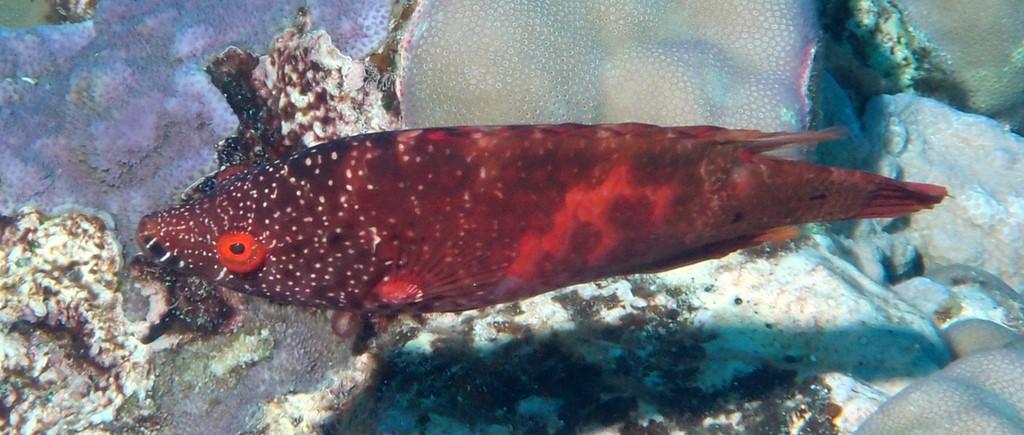CHEILINUS OXYCEPHALUS - (BLEEKER, 1853)
Actinopterygii (Gigaclass) > Actinopteri (Class) > Teleostei (Subclass) > Labriformes (Order) > Labroidei (Suborder) > Labridae (Family) > Cheilinus (Genus)
Labre prétentieux, Labre rouge maori, Red maori wrasse, Snooty maori wrasse, Snooty wrasse, Pointhead maori-wrasse, Plain-faced maori wrasse, Pointed head maori wrasse, Point-head maori, Snob-lipvis, Maorí Carmesí, Mitsuboshimochinouo, ミツボシモチノウオ, 尖头唇鱼, 尖頭唇魚,
Synonymes
Cheilinus calophthalmus (Günther, 1867)
Cheilinus ketlitzii (Valenciennes, 1840)
Cheilinus sanguineus (Valenciennes, 1840)
---------------------------
Description
Dorsal spines (total): 9-10; Dorsal soft rays (total): 9-10; Anal spines: 3; Anal soft rays: 8; Pectoral fin rays: 12; Body depth: 2.4-3.0 in SL; Head profile concave from mouth to above eyes; Snout short, length: 3.1-3.7 in HL; Snout appears upturned due to dorsal concavity; Pelvic fins short, length subequal to pectoral fins and usually just reaching anus; Soft-rayed portions of dorsal and anal fins not acutely pointed; Caudal fin rounded in all stages. Lateral line scales: 15-16 + 6-7; Head scaly to above middle of eyes. Max. length: 17.0 cm TL. Depth range: 1 - 40 m.
Color
Color variable, usually brownish red, but may be bright red or olive mottled with small whitish spots; juveniles and subadults often with 4 irregular narrow whitish bars across body; 3-4 dark brown spots of about pupil-sized midlaterally on posterior half of body, last at midcaudal fin base; Each side of upper lip usually with 2 or 3 close-set, square, dark brown spots; Often 2 dark lines diverging behind eye; Dark brown or black spot of pupil size or larger on membrane between first 2 dorsal fin spines, partly bordered in red, sometimes extending onto 2nd membrane.
Etymology
Cheilinus: from Greek, chèilos = lip. Referring to extensible upper lip of Cheilinus trilobatus (Lacepède, 1801).
oxycephalus: from Greek, oxus = sharp, acute, pointed + from Greek, -kephalos = head. Described as having a pointed head (“capite acuto”).
Original description: Cheilinus oxycephalus Bleeker, 1853 - Type locality: Ambon Island, Molucca Islands, Indonesia.
Distribution
Indo-West Pacific: KwaZulu-Natal (South Africa), East Africa, Socotra (Yemen), Seychelles, Comoros, Madagascar and Mascarenes (La Réunion, Mauritius, Rodrigues), east to Marquesas Islands and Gambier Islands (French Polynesia), north to southern Japan and Ogasawara Islands (Japan), south to Western Australia, Queensland (Australia), New Caledonia and Austral Islands (French Polynesia).
Biology
Found in coral-rich areas of lagoon and seaward reefs. A secretive species, rarely ventures more than a few centimeters from shelter. A shy species, usually found in pairs when adult. Oviparous, distinct pairing during breeding. Aquarium fish.
Similar species
Last update: 1, September 2024
Labre prétentieux, Labre rouge maori, Red maori wrasse, Snooty maori wrasse, Snooty wrasse, Pointhead maori-wrasse, Plain-faced maori wrasse, Pointed head maori wrasse, Point-head maori, Snob-lipvis, Maorí Carmesí, Mitsuboshimochinouo, ミツボシモチノウオ, 尖头唇鱼, 尖頭唇魚,
Synonymes
Cheilinus calophthalmus (Günther, 1867)
Cheilinus ketlitzii (Valenciennes, 1840)
Cheilinus sanguineus (Valenciennes, 1840)
---------------------------
Description
Dorsal spines (total): 9-10; Dorsal soft rays (total): 9-10; Anal spines: 3; Anal soft rays: 8; Pectoral fin rays: 12; Body depth: 2.4-3.0 in SL; Head profile concave from mouth to above eyes; Snout short, length: 3.1-3.7 in HL; Snout appears upturned due to dorsal concavity; Pelvic fins short, length subequal to pectoral fins and usually just reaching anus; Soft-rayed portions of dorsal and anal fins not acutely pointed; Caudal fin rounded in all stages. Lateral line scales: 15-16 + 6-7; Head scaly to above middle of eyes. Max. length: 17.0 cm TL. Depth range: 1 - 40 m.
Color
Color variable, usually brownish red, but may be bright red or olive mottled with small whitish spots; juveniles and subadults often with 4 irregular narrow whitish bars across body; 3-4 dark brown spots of about pupil-sized midlaterally on posterior half of body, last at midcaudal fin base; Each side of upper lip usually with 2 or 3 close-set, square, dark brown spots; Often 2 dark lines diverging behind eye; Dark brown or black spot of pupil size or larger on membrane between first 2 dorsal fin spines, partly bordered in red, sometimes extending onto 2nd membrane.
Etymology
Cheilinus: from Greek, chèilos = lip. Referring to extensible upper lip of Cheilinus trilobatus (Lacepède, 1801).
oxycephalus: from Greek, oxus = sharp, acute, pointed + from Greek, -kephalos = head. Described as having a pointed head (“capite acuto”).
Original description: Cheilinus oxycephalus Bleeker, 1853 - Type locality: Ambon Island, Molucca Islands, Indonesia.
Distribution
Indo-West Pacific: KwaZulu-Natal (South Africa), East Africa, Socotra (Yemen), Seychelles, Comoros, Madagascar and Mascarenes (La Réunion, Mauritius, Rodrigues), east to Marquesas Islands and Gambier Islands (French Polynesia), north to southern Japan and Ogasawara Islands (Japan), south to Western Australia, Queensland (Australia), New Caledonia and Austral Islands (French Polynesia).
Biology
Found in coral-rich areas of lagoon and seaward reefs. A secretive species, rarely ventures more than a few centimeters from shelter. A shy species, usually found in pairs when adult. Oviparous, distinct pairing during breeding. Aquarium fish.
Similar species
- Cheilinus abudjubbe (Rüppell, 1835) - Reported from Red Sea; Northwestern Indian Ocean: Gulf of Aden. Max. length: 21.8 cm SL.
- Cheilinus chlorourus (Bloch, 1791) - Reported from New Caledonia - Link to the species (here). The only Cheilinus that has 10 dorsal spines. Large adults have numerous red spots and streaks on the head and trilobed caudal fins. Max. length: 45.0 cm TL.
- Cheilinus trilobatus (Lacepède, 1801) - Reported from New Caledonia - Link to the species (here).
- Oxycheilinus bimaculatus (Valenciennes, 1840) - Reported from New Caledonia - Link to the species (here). Juveniles are similar.
- Oxycheilinus nigromarginatus (Randall, Westneat & Gomon, 2003) - Reported from New Caledonia - Link to the species (here).
Last update: 1, September 2024
